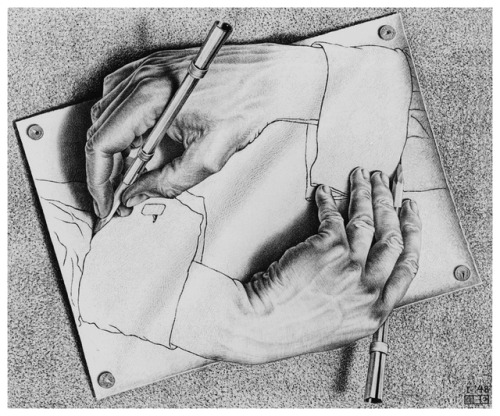

Why do so many people struggle to stick to a healthy lifestyle?
We, collectively, have access to more information related to health and biology than any previous generations of humans. And research suggests that programs focused upon education on healthy eating and physical activity are not particularly effective at driving behavior change.
So, it’s probably not strictly due to a lack of knowledge.
Here’s why it is so hard: Health-related goals are the product of long term modifications to aspects of our daily life. And we don’t see much payoff from these choices individually, at least not in the moment.
For instance, if I go run on the treadmill for an hour tonight, I won’t observe a dramatic difference in my VO2 max right away, as a result of that singular effort. And on the opposite end of the spectrum, if I skip the gym entirely today, it won’t make an appreciable difference in my health or body composition or anything else in the short term.
To paraphrase James Clear, it is only after your efforts have compounded over time that you start to see the payoff of these behaviors, for better or for worse.
But therein lies the problem – we are short-term creatures, and most of us aren’t able to easily identify these subtle benefits and costs when we are actually making these countless health-related choices every day.
Making things even worse, the behaviors that support our goals tend to be vastly less rewarding in the moment than the actions that oppose them. French fries, generally speaking, taste way better than kale chips. The modern environment and our hedonic impulses are constantly working against us.
So how do we overcome this?
Well, one tried and tested method is to track progress over time. This enables us to continuously see what’s working – and what isn’t working – and helps keep us accountable and committed to the behaviors that support what we are trying to achieve.
This is true of pretty much any health- or fitness-related objective that you could imagine, but it has particularly obvious application to body composition goals.
Just as one example, research on participants in the National Weight Control Registry has shown that individuals who successfully keep weight off over the long term typically weigh themselves regularly and log their food intake, and a drop in frequency of self-weighing is associated with greater risk of regain in this group.
But for this sort of tracking to be really effective, ideally you would want the most accurate data, right? And with respect to body composition, not all methods are created equal. The scale, in particular, is a fairly limited and sometimes misleading tool.
And that brings me to our guest for this episode.
GUEST
On this episode of humanOS Radio, Dan talks with Jason Belvill. Jason is the CEO and Co-founder of BodySpec, a company that offers DEXA scans on the West Coast.
DEXA (dual energy x-ray absorptiometry), as you probably know, has been demonstrated to be one of the most reliable ways to estimate body composition, and offers a number of advantages over other methods.
For one thing, the scan is able to differentiate between fat, bone, and fat-free mass. This means that it not only can distinguish between fat and lean tissue, unlike a scale, but it is also not subject to errors associated with variations in bone density.
DEXA can also provide measurements for specific areas of the body, meaning that it can highlight differences in where fat is distributed. This is more valuable than you might think, because visceral adipose tissue in particular appears to be closely associated with development of type 2 diabetes, especially in certain ethnic groups who are predisposed to it. And it can be surprisingly tricky to tell if someone is carrying an unhealthy amount of visceral fat, especially in people who have a normal body weight and look relatively lean.
So what’s special about BodySpec? Well, BodySpec offers the least expensive DEXA scans available in the country as far as I know ($45 per scan, compared to as much as $100 or more at other providers). They also perform RMR (resting metabolic rate) tests and VO2 max tests at some locations, so you can gain a lot of insight into your body and your performance if you pay them a visit.
But what truly sets BodySpec apart is that they are mobile. BodySpec has a fleet of DEXA scan trucks that can be booked at gyms, offices, and events throughout the west coast. So you can go to their storefront, or they can come to you.
Services like BodySpec make it extra easy to quantify your body fat, muscle, and bone density, and then track over time how your training and diet regimen is affecting all different regions of the body. To learn more about the merits of DEXA, and why you might want to get a DEXA scan yourself, check out the interview below!
LISTEN HERE
On Soundcloud | Spotify | Apple Podcasts | Google Play | Stitcher | iHeartRadio | Overcast.fm | YouTube
YOUTUBE
SUPPORT
Have you considered becoming a Pro member of humanOS.me? It costs just $9.99 per month, and when you go Pro, you get access to all our courses, tools, recipes, and workouts. Pro members also support our work on blogs and podcasts, so thanks!
LEAVE A REVIEW
If you think other people would benefit from listening to this show, you can help us spread the word by leaving a review at iTunes. Positive reviews really help raise the profile of our show!
TRANSCRIPT
| Jason Belvill: | 00:00 | … be diligent about how you’re tracking because if you are diligent about that, that’s when you’re going to get the biggest ROI for the time and the effort you’re spending to get that information because that’ll be the info that allows you to make change. |
| Dan Pardi: | Many people struggle to maintain weight loss or with health in general. We addressed this before on the show. Health-related goals are largely the product of long-term modifications to how we live, and we generally don’t see an immediate benefit from these individual choices. For instance, if you go for a run on a treadmill for a half an hour, I’m not going to see that I lost 20 pounds or I’ve made a dramatic difference to my VO2 max. For that matter, if I skip the gym today entirely, I won’t make an appreciable difference in the short term either. To paraphrase James Clear, “It’s only after your efforts have compounded over time that you start to see the payoff.” But what can we do to ensure that we’d see that pay off? One tried and true method is to test your progress over time. This enables us to see what’s working and what isn’t working so that we can tinker and modify our strategy and helps us stay accountable to the goals that we’ve committed to. | |
| Dan Pardi: | 00:16 | But for this to be effective, ideally we would be using objective and accurate data. With respect to body composition in particular, there are many different methods for assessing body mass and body fatness, but these methods are not all created equal. In fact, some are shockingly misleading. That is why I’m pleased to have Jason Belvill with me on the show today. Jason is the CEO and co-founder of BodySpec, a company that offers DEXA scans here on the West Coast. BodySpec offers the least expensive DEXA scans available in the country as far as I know, and they also offer other health and metabolic assessments too. But what’s really cool about BodySpec is that they are mobile. |
| Dan Pardi: | They have body fat scanning trucks that you can book at your gyms or offices or events. So you can either go to one of their storefronts or even have them come to you. We’ll talk a bit about exactly what DEXA is and the relative merits of DEXA versus other measures of body composition and when someone might want to get a DEXA scan here. Jason, without further ado, welcome to the show. | |
| Jason Belvill: | 01:01 | Thanks for having me, Dan. |
| Dan Pardi: | How did you get interested in health and performance? | |
| Jason Belvill: | 01:33 | So I grew up playing soccer. That was my sport and I eventually competed at the Air Force Academy. So, I played soccer for the Air Force in the division one school. And then I played a little bit beyond as well. I competed for the military World Cup team. The US has a military soccer team that goes off and competes against Germany’s military World Cup and Brazil’s and so on. So I did that for a number of years as well. I mean, I’ve always been in the space, a big proponent of health and fitness and sports and just taking care of yourself. |
| Dan Pardi: | I love it. When you were competing, who was the best team? | |
| Jason Belvill: | 01:50 | Brazil is probably. I mean, it’s usually the best for the men’s in general at the real World Cup level. But when we competed against them, they blew us out. |
| Dan Pardi: | I appreciate that honest answer. Okay, so your company offers DEXA scans, explain to the audience what exactly DEXA scans are? | |
| Jason Belvill: | 01:52 | It’s a really low dose x-ray and what it does is it profiles your entire body. The scan takes maybe five to seven minutes and you lay down on a flat bed, an x-ray passes over you. And while it’s doing that, it’s differentiating and measuring between fat tissue, lean tissue and bone mineral content. So it’s essentially profiling you head to toe. It’s an incredibly safe scan. So a lot of people get nervous about an x-ray, but it’s the equivalent of an individual standing outside for half a day. So the exposure is really minimal. But the data is incredibly thorough and granular, which makes a DEXA scan the gold standard of body composition testing. |
| Dan Pardi: | So we get an idea of the different types of methods that are used for this purpose, what are the different types, and we then can compare them? | |
| Jason Belvill: | 01:54 | That’s actually a good subject to talk about because there’s a lot of methodologies to measure body comp. If I was going to prioritize them, if I was going to rank order them, I would say that DEXA scans are at the top of the pyramid. There’s just a lot of clinical research and medical studies validating DEXA and the efficacy of DEXA scans. But then right below that, I would say that hydrostatic testing and or BOD PODs. So, a lot of people call those egg shaped machines, those are actually called BOD PODs. Those are dependent on algorithms having to do with volumetric displacement and stuff. So they were previously the gold standard before DEXAs became more widespread and more commonplace, but we used both of those methods when I was in school as well. Very common, very popular. Also cost effective, so you would pay something similar, $50, $75 a test. And then as you stepped down the pyramid, I would say that in bioelectrical impedance, the technology has improved a lot over the years. |
| Jason Belvill: | There’s still variance with the measurements, especially because it’s dependent on hydration levels. And so, results can be skewed depending on how hydrated or dehydrated you may be. And so, just in terms of a precision and consistency standpoint, you can have issues there. But if you’re consistent with it, if you wake up every morning and you’re fasted, you tested the same time and in the same conditions, it can provide you with reasonable trend data. | |
| Jason Belvill: | 02:24 | So I would say bioelectrical impedance is next gallon and then you have things like skinfold calipers, which had been around for years and there’s different ways to use skinfold calipers. There’s different sites that you can test and there’s different algorithms that you can use with the skinfold calipers. But again, dependent on the administrator in terms of accuracy and precision. And there’s some other ways that are coming out on the market as well. I mean, I think there’s an ultrasound now. That’s a new methodology that I’m not as familiar with. And there’s different anthropometric methods. The Navy method is one where they measure your neck and your waist circumference and back it into your body comp from some algorithms. So again, number of ways to do it. |
| Dan Pardi: | You might get a laugh at this, but in my exercise physiology class in college I learned about skinfold measurements and learned how to do it and I wanted to get good at it. So I put a sign on my door in the dorm that said that I would take people to do their body fat and I ended up doing 80 people. Then they wanted to get it done every month. And so, I didn’t actually ever regret it but I thought I got pretty good at it [crosstalk 00:05:50]. | |
| Dan Pardi: | 02:27 | I’ll say one other thing too about the bioelectrical impedance. Those have the advantage of ease. We have so many different scales now, these wifi scales. You can just step on them in the morning and you’re going to get a measurement. But the way that I interpret that data is really not to look at the daily fluctuations because it’s going to vary quite a bit. But try to look at the trend over, let’s say a month of time. And I wish they actually provided that data first and foremost, which is here’s the average of your last two weeks and let’s see how that … like you said, let’s see where the trend is going. But even though I still do that, I’ve been doing the body spec DEXA scans recently and I’ve gotten a whole different quality of feedback that I’ve really valued. |
| Dan Pardi: | So let’s jump to why might somebody want to get a DEXA scan in the first place? | |
| Jason Belvill: | 02:38 | We work with such a wide spectrum of clients. So the why could be slightly different for every person. I mean, we work with medically supervised weight loss patients and we work with professional athletes and so the why might be a little bit different based on those two individuals. But I think fundamentally, you have to get the data. Right? In order to make any type of improvement, whether you are just starting out in your journey and you’re 40% body fat, which is common. I mean we see that a lot. That’s not to place judgment. This is just a starting point and good for that person to take charge and want to get this information so that they can make improvements. And it’s the same thing for a really elite athlete. If they’re trying to fine tune themselves, their performance, their bodies, their health, there is no other way to do that unless you have the data to either validate what you’re doing or give you feedback that what you’re doing isn’t working. |
| Jason Belvill: | And I think you said that at the beginning of your introduction or some form of it. I mean, you can’t improve what you don’t measure. So, that’s kind of the bottom line. That’s why we’ve been so successful in this space because the data that we give is really actionable. It sets benchmarks and it also sets goals for folks to be able to understand where they are today. And what’s reasonable and realistic for them to get to two months from now, six months from now, a year from now, and just really kind of help every individual regardless of where they are on that health spectrum that I talked about earlier, achieve those goals. | |
| Dan Pardi: | 02:46 | For me, some of the big advantages was seeing not only the amount of muscle mass I have, total fat mass, but also being able to see not just subcutaneous fat, which is the fat under the skin, but also get a reading of visceral fat. We know that that type of fat stored around your viscera or your internal organs is more problematic. And frankly I was starting to feel … I was describing it as “poochy.” Like, my stomach was sticking out and even though I wasn’t feeling additional subcutaneous fat. |
| Dan Pardi: | So, that was actually one of the inspirations for me to come back because I didn’t want to earlier a few years ago. And then I said, “Okay, what’s going on? Let me get it checked.” And I had a little more visceral fat than how you would want. And it actually sort of matched up with what I was thinking was going on. And so I did make some changes to how I’m living and then I just, of course a couple of days ago got a secondary scan and I saw some things were going in the right direction. So real world example of how getting that additional resolution to this into your body helped me then sort of say, “Okay, I don’t want to be here. I know what’s going on. I don’t want to be here, I’m going to make some changes.” And I saw that those changes are working too. So that was thumbs up from me on that. | |
| Jason Belvill: | 03:22 | Definitely. And with the DEXA, with our report specifically, and I didn’t really touch on this earlier. But with the data that we provide, it is more than just, here’s your fat muscle and bone and see you later. I mean, we break the information down regionally in your body so you can also see and identify how much fat and muscle you’re carrying in your arms. What’s the breakdown of your legs, your trunk region, your abdominal region. And that’s done intentionally because Dan, you and I could shake hands today and say, okay, let’s go on a 60 day journey. We’re going to eat exactly the same thing. We’re going to train exactly the same way. We’re going to sleep the exact same amount of hours every night. We could try and parrot each other as best as possible the next 60 days. Our bodies would likely respond very differently. |
| Jason Belvill: | And in that course, `you might lose a pound of fat from your abdominal region. I might gain two pounds of muscle in my leg region. And so that supports how unique and personable this data is for each individual. And so that’s why I love the information that we provide because it just provides such an in-depth look at you as an individual. And on top of the regional visceral fat that you mentioned, it also gives an estimate for your resting metabolic rate, gives you an idea of what your bone density is and how you compare it to other individuals in your same demographic. It can look at muscle symmetry as well. | |
| Jason Belvill: | 03:29 | So, it’s not as relevant for all folks, but we do have clients that come to us who are coming off an ACL surgery or a rotator cuff surgery and they’ve been atrophied on one side of their body and we might see a two or three pound delta between their right and left limb. That’s an issue. That’s a concern, and obviously it’s important for that individual as they’re rehabbing, they’re in post-op and stuff to try and prove that and close that gap. That’s information that we can provide to give them those insights on how effective the rehab is going. So a lot of different uses and benefits for the data. |
| Dan Pardi: | For sure. I can imagine being a coach, I’d want to have that information on my players and players are always going to say, “I’m ready to go.” They’re itching to get back. But if you see a really big disparity in terms of the size of the muscles between the left and right limb, you might then affect how much they’re training, when they’re really ready to get back to the court or the playing field. One thing I neglected to ask earlier because we were talking about hydration in the body, weight scales, the bioelectrical impedance. What about hydration for DEXA? Does that actually matter? If I come in, let’s say, dehydrated or I had 10 bowls of miso soup last night and I feel a little blimpy. Does that matter? How does the DEXA scan account for that? | |
| Jason Belvill: | 04:24 | It can have an impact to be honest, and we’ve done our own experimentation early on because clients were curious about it. They’re curious about how that could affect the results. And so, it helps to have a little bit of context about how the DEXA actually is measuring folks. DEXA stands for dual energy x-ray, so there’s actually two x-ray energy beams going through an individual and profiling the tissue and they’re specifically measuring fat and bone because those tissue compositions have really [inaudible 00:11:40] densities. Fat being really gelatinous, bone being a little bit more dense, hard. |
| Jason Belvill: | And so, lean mass then, is considered everything else. That’s an important concept because it includes your skeletal muscle, of course, your biceps and your quads. But it also includes blood and your organs and water. So from that perspective, if you came in right now, Dan, and you measured and you were completely fasted and had to eat or drink all day and we measured you and then you decided to chug a gallon of water and scan immediately after that, which is really hard to do. I did it a few years ago. I chugged a gallon of water and it’s 8.2 pounds of water in 30 minutes and then scanned again and then the lean mass was impacted, showed a seven-and-a-half jump in lean tissue. So I mean there’s more mass in my body. We have to show it somewhere. And so, it went into the category that we have anticipated. So it can affect it. | |
| Dan Pardi: | 04:47 | So to me then that says if you’re going to go get one of these scans, try to get it at the same time of day, probably mornings preferable perhaps, but try to be consistent, if anything, get it at the same time. |
| Jason Belvill: | Consistency. Yeah. | |
| Dan Pardi: | 05:25 | So you talked about you have this ionizing radiation that’s part of the scanning and I understand that some of the health risks for radiation are measured in what are called sieverts and you talked basically being outside. Getting one DEXA scan is like being outside for half of a day. I also saw on the site that one DEXA scan is equal to about four bananas, which I thought was an interesting comparison, very innocuous when it’s put that way. So tell us about frequency. And I know this probably depends on the individual as well, but what frequency do you talk about to the people that come in? Give me some ranges of what you might recommend. |
| Jason Belvill: | On average, we’re encouraging folks to scan every two to three months, and we feel like that is a reasonable cadence. It’s not over testing and it’s not obsessing about the data, but it gives you time to get a scan, get feedback, and then go off and implement change. It takes a while to create habits and form habits. I mean, upwards of 60, 70 days of doing something consistently to really ingrain it into your lifestyle and make it a part of you. And so, from that perspective, we recognize that dieting is hard going on these extreme training programs and stuff. It’s just, a lot of that stuff is … it’s hard to sustain. Right? It might be easy to jump into, which a lot of folks can probably attest to on January 1st every year. But sustaining that stuff is tricky. And so if you space these things out and put some dates on the calendar incrementally, every two to three months, it gives something you look forward to. It gives you a goal, a benchmark milestone to retest. | |
| Jason Belvill: | 05:50 | But to your point, it does depend, right? I mean, we have folks that do the Whole 30 challenge and so they’ll test on day one and they’ll test on day 30 because they’re involved in a really deliberate and focused nutrition framework for those 30 days. It’s really restrictive. And so they want to see the impact of those changes. Some folks will scan with us once a year and they come in and they just want the general checkup. They just want to see where they are, knowing that they haven’t probably made significant changes throughout the year and they just want to make sure things are still in check. So I always stick to two to three months as a reasonable cadence. |
| Dan Pardi: | Here’s my thoughts about it which parallel with yours nicely. But if you’re implementing a strategy for a goal, frequency of testing is probably higher, right? You want to maybe shorten that time span. So the two to three months makes a lot of sense because you want to see the progress is being measured in the ways you’d like to. So you’re getting lots of fat gain and muscle typically? | |
| Jason Belvill: | 06:27 | Right. |
| Dan Pardi: | As another strategy, would be the once a year check-in, just going to get a physical. It’s another set of data that’s valuable and if you’re not necessarily making a lot of changes, you’re just looking for stability. You don’t have any specific goals. It’s a nice way to check in. And one other thing that I would say, particularly for people in the beginning of the year, if you do have some goals and you want to lose weight, putting that date on the calendar like you recommended is actually another lever to increase your own compliance with your goals there. Because you’ve got this date coming up where I’m going to get things tested and I think that that can help sharpen your focus a bit. | |
| Jason Belvill: | 06:31 | It’s like getting ready for a test. I know it’s on the calendar. I mean, you have to study at some point for it, but it just helps to trigger the lifestyle changes and get focused on hitting that mark. So I mean, consider a bodybuilder, right? We have a number of folks competing bodybuilding industry, fitness competitions. As they’re gearing up for competition, they may test once a week for a month, for example, and just really trying to zero in and dial things down and you get the full spectrum. We’ve had some clients now … so we’ve been operational for five years. We launched this in 2014, and I think we have a couple of clients who’ve scanned over 40 times, I want to say. So there’s some folks that they really take this seriously. |
| Dan Pardi: | Well I can imagine in the competition area where your body composition is the game then that degree of testing, again, speaking to behavior, I mean things get increasingly challenging once you’re trying to go from an already low fat percentage to even lower. And I could see the value of doing that and also the behavioral thing like all right, I’ve got one week before I’m testing again. I better prepare all my food today. So I know from the DEXA scan you get an estimate of your resting metabolic rate, but you also test that directly. Tell us about what that test looks like. | |
| Jason Belvill: | 07:23 | So we offer the rest of the metabolic rate test only in California. We have it set up at our offices in Culver City and San Francisco. And then we do have a mobile unit in the Bay area. This test is the actual measurement. So the number you’re getting on the DEXA report is an estimate, but the test that you do, it’s a 15 minute breathing test essentially. So what it requires is that you’re completely fasted, no exercise before the test, no nicotine, no food. It’s a restrictive test because it’s trying to simulate what your metabolic activity is at a completely restful state, almost as though you just woke up first thing in the morning and were laying in bed. As you’re breathing into this machine, and again, you’re just breathing at your normal cadence and a machine that has oxygen sensors in there and the data, it’s based off indirect calorimetry so it can actually measure what your metabolic activity is in a rested state. |
| Jason Belvill: | It translates that into how many calories burn in a given day in a 24 hour period, if you were literally to do nothing, to just wake up and lay there. It’s an important number and especially if you’re counting calories or your nutrition programming is pretty dialed in and there’s different frameworks that are more dependent on calories and understanding calories and macros. And so that’s the foundational number that you need to start with and then you build out your plan and your program from there based on your activity levels and the things that you’re eating and your macro splits and everything else. | |
| Dan Pardi: | 07:53 | If you have that number, that’s a great starting place. Then you can look at your total daily energy expenditure, which is factoring in your resting metabolic rate with the amount and type of activity you’re doing to then give more accurate estimates of the amount of calories you’re actually burning and then you could try to pair that with let’s say My Fitness Pal or some sort of calorie tracker. If you’re really trying to dial that in and maintain a certain degree of deficit and make sure that you’re getting enough protein, let’s say within the calories you are consuming, it’s very effective. Not everybody wants to count calories, but a lot of people who do that are doing fitness competitions. I mean, have that degree of resolution and you can really get great results. |
| Dan Pardi: | One approach I’ll recommend for people looking to lose some weight. In the beginning of the year we have two different diet programs, the flash diet and simple food diet, part of the idea weight program and we give some recommendations about how much protein you should be aiming for. It’s what we feel the research tells us about where the efficacy of protein in suppressing appetite and maintaining muscle peaks out. You can eat more than that if you’d like, but getting that number in your protein target is really an effective strategy. But measuring along with it for the reasons we’ve discussed, getting a baseline and seeing that progress in whatever diet you choose to do, it’s a good way to go. | |
| Jason Belvill: | 08:18 | Definitely. |
| Dan Pardi: | What sort of variants do you see between your estimated RMR from the DEXA scan and the measured RMR and in what populations might that be best for them to do both? | |
| Jason Belvill: | 08:50 | So the big variations tend to come from profiles that are on the extreme ends of a body composition profile. So, for example, a rugby player who’s 240 pounds and 12% body fat and is just built like a brick. The DEXA might estimate his RMR at, I’m just throwing numbers out there, 2,200, 2,100 calories, let’s say. If he actually goes to measure his RMR, I’ve found that individuals RMR can be upwards of 3000 calories just based on his profile and the energy demand that he requires. That’s one example. It’s like body composition where they’re incredibly lean individuals with a lot of lean mass. The estimate doesn’t really keep up, so that would be a good time to get the RMR measurement. And then on the other end of the profile, if my composition is pushing higher levels, 40%, 50% body fat, for example, it would be something similar because there’s just too big of a delta with fat tissue and lean tissue for the measurement to pair up with the estimate that’s coming off the DEXA. So does that make sense? |
| Dan Pardi: | Oh yeah. I’ll mention one other population. People that have previously been a much higher weight and have now lost a good amount of weight. There’s a little debate on that in the literature, but your RMR might actually be lower than what you would expect given the amount of lean mass you have. But it might not. I haven’t done it yet, but I’m curious to get it done to see how those two numbers align. And if they’re different, then I’ll know to continue to do both simultaneously. And if they’re not, then I’ll feel just getting the estimate’s going to be good enough going forward. Where can people find you? | |
| Jason Belvill: | 09:35 | We have an office in Culver City, California, so that’s in Southern California. And then we have another office in San Francisco, so it’s at 295 Broadway. It’s right downtown in the financial district. And then we have two mobile units in Southern California, four mobile units in the Bay Area. We have two in Seattle. We have one in Austin, Texas. So we’ve kind of expanded our reach to both Washington and Texas now, Austin, Texas. |
| Jason Belvill: | And so mobile events were … that’s exactly what we are. We’re mobile. And so we drive all around and all of our events are listed on our calendar. The majority of them are publicly accessible. So if you live in California or Washington or Austin, Texas, I know Texas is big. Austin, Texas. It’s as simple as going to our website, bodyspec.com and filtering out the region that you live`, the area that you live. And you can see a list of all the events that we have in your area and appointments are booked online and it’s an incredibly efficient process. We book appointments in 16-minute time intervals. We’re very militaristic with our appointments. But that gives you enough time to get in and get tested. And then it gives us an opportunity to review results as well. And then you’re on your way, you’re ready for the rest of your day. | |
| Dan Pardi: | 10:08 | How long does it take to get the results back? And when you said review the results, who does that? |
| Jason Belvill: | Yeah, so the operators that are running the trucks or the technicians that are at the office, they are the ones that are doing the scans and reporting the information, analyzing it, and then they can also provide a breakdown of the results. So they would walk you through and explain the result profile top to bottom, answering questions you have and just help you understand, especially for individuals who are getting the data for the first time. It’s a lot of information to digest at once, so we want to be there, we want to be a resource to help people understand it. And then we also offer remote consultations as well as part of our service. So there’s no extra charge for that where we can set up phone calls with folks and even spend more time reviewing the results and answering any questions they have. So that the reporting process, the scan process, it all fits in that 16-minute window. | |
| Jason Belvill: | 10:41 | So everything from you checking in, getting set up, meeting our technician, getting ready for the test, doing the tasks, having the results analyzed, reviewing the result. We have the operation down and we don’t like to waste people’s time. So that happens in 16 minutes. |
| Dan Pardi: | That’s my experience. It’s very efficient to get it and I never feel rushed at all in the back end of that. You’ve got plenty of time to speak with the people about the results afterwards, so it’s been overall a nice experience for me. The listenership for the podcast is much broader than the areas that you serve. What would you recommend to somebody who’s listening to this and interested in getting this done to have a better understanding of their body composition? What do you recommend to those people? | |
| Jason Belvill: | 11:15 | I have a bias towards DEXA scanning. I would encourage and suggest that you search a local university or a hospital or human performance lab. Just search DEXA body fat testing and see if there’s something local that exists. Again, I don’t think that there’s anything better in terms of accuracy and granularity of data. That said, if something doesn’t exist or it’s not accessible or affordable, because a lot of DEXA scans cost a lot more than $45, then I think the next best option I would steer people towards is either a hydrostatic test or a BOD POD. Either or. And then again, just loose stepping down that pyramid. |
| Jason Belvill: | The next thing I would say is maybe a body scale or some type of bioelectrical impedance scale that you have access to consistently. But really for body composition and data you want to start … you want to get the data and then you just want to be consistent with tracking that. So if you do end up at your local gym, you have an in-body scale and you have access to that and it’s affordable, then you would use that and use it over time and use it consistently and just be diligent about how you’re tracking. Because if you are diligent about that, that’s when you’re going to get the biggest ROI for the time and the effort you’re spending to get that information because that’ll be the info that allows you to make change. | |
| Dan Pardi: | 11:44 | Do you have plans to continue to expand? |
| Jason Belvill: | We do. I’m not sure what the next state is or where the next market is, but absolutely. We’ve proven the model and the demand is high for our service and we pride ourselves on offering a quality service and really taking care of the client. And so to that extent, yeah, if we can get this in front of more people and keep the price points low and make it accessible, I think we’re on track to help a lot of people make positive and impactful changes in their lifestyles. | |
| Dan Pardi: | 12:35 | Jason, thank you for this. I’ve been aware of DEXA scans for a long time. The first one I’ve ever got done was through you guys, and you’re really making this sophisticated process super easy and attainable for those who live in an area where it’s there. So I do hope that you continue to expand and that more people take part in this because it’s invaluable for me and I’m appreciative that you’re in the Bay Area, so thank you for starting BodySpec. It’s a great service. |
| Jason Belvill: | Appreciate it, Dan. Yeah, thanks again for having me on today, it was great. |
The post How DEXA Can Help You Achieve Your Goals. Podcast with Jason Belvill appeared first on humanOS.me.





















